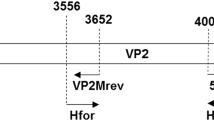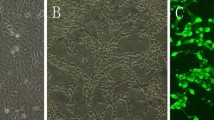ABSTRACT
Canine parvovirus (CPV) was first recognized in the late 1970 s in dogs and has mutated and spread throughout the world in canid and felid species since then. In this study, a novel CPV was isolated from the endangered red panda (Ailurus fulgens) in China. Nucleotide and phylogenetic analysis of the capsid protein VP2 gene classified the red panda parvovirus (RPPV) as a CPV-2a type. Substitution of Val for Gly at the conserved 300 residue in RPPV presents an unusual variation in the CPV-2a amino acid sequence and is further evidence for the continuing evolution of the virus. The 300 residue is important in distinguishing the antigenicity and host range of CPVs. The clinical significance and population impact of RPPV infection in captive red pandas in China is unknown and is an important topic for future research.
Similar content being viewed by others
Avoid common mistakes on your manuscript.
Introduction
Parvoviruses are encapsulated, single-stranded DNA viruses that infect a variety of animal species. The canine parvovirus (CPV-2) appears to have evolved from the feline variant (feline panleukopenia virus, FPLV) and was first described as a clinical entity causing enteritis in dogs in 1978 [1, 2]. It affects primarily young animals in which it causes haemorrhagic enteritis and myocarditis. By 1980, CPV-2 had spread throughout the world in canids and subsequently evolved two new genetic and antigenic variants, CPV-2a and CPV-2b, which also regained the feline host range [2, 3]. Recently, another antigenic strain designated CPV-2c was identified in leopard cats in Vietnam [4].
The VP2 capsid protein is important in the determination of antigenicity and host range of CPVs. Five amino acid substitutions in the VP2 capsid protein differentiate CPV-2 and CPV-2a/b (Met-87 to Leu, Ile-101 to Thr, Ala-300 to Gly, Asp-305 to Tyr and Asn-375 to Asp) [3]. The substitution of Asn-426 with Asp differentiates CPV-2a from CPV-2b.
Canine parvovirus has been described in a variety of canid and felid wildlife species [3]. It has not yet been reported in the red panda (Ailurus fulgens, Family Procyonidae), which is an endangered species native to the Himalayas [5] and southern China [6]. The red panda parvovirus (RPPV) VP2 gene described here identifies yet another variant of the virus. It demonstrates the continued adaptation of the virus to an ever-expanding host range that includes endangered species of wildlife. Understanding emergent disease threats is important in enabling effective conservation measures for endangered species.
Materials and methods
Sample collection
Seventy-one rectal swabs were collected opportunistically during a serologic survey of red pandas in 10 Chinese captive facilities during October–December in 2004. None of the animals exhibited clinical signs of parvovirus infection at the time of sampling. The samples were taken with sterile cotton buds, which were then stored in buffer (50% glycerine in physiological saline) and shipped on ice to the laboratory at the Institute of Zoology, Chinese Academy of Sciences, where they were stored at −80°C until analysis.
DNA extraction and amplification of the CPV VP1/VP2 gene
Viral DNA was extracted from the buffer in which the rectal swabs had been stored with the QIAamp DNA mini kit (QIAgen, Valencia, California, USA) according to the manufacturer’s instructions. Nested PCR was performed using the following primers to the CPV VP1/VP2 gene: p1: 5′-AAAGAGAGCCAGGAGAGGTA-3′, p2: 5′-TTCTGACAGCAGGTTGACCA-3′, p3: 5′-GGGTGTGTTAGTAAAGTGGG-3′, p4: 5′-TCTGGTTGAACTGCTCCATC-3′. Primers were synthesized by TaKaRa Biotechnology Company (Dalian, China). The reference strain of CPV-2 was supplied by the National Veterinary Diagnostic Center in Beijing, China. Primers p1 and p2 (outer primer pair) were used for the first round of PCR. Primers p3 and p4 were added to a subsample of the first round of PCR product for re-amplification. Both rounds were amplified under standard conditions with 10 pmol/l primer and 35 cycles (first PCR) or 25 cycles (second PCR) of amplification (94°C 30 s, 55°C 30 s, 72°C 60 s). Positive and negative controls were set for each PCR with reference strain DNA and distilled water, respectively, as templates.
Red panda parvovirus culture
The three PCR-positive rectal swab samples were filtered through a 0.22 μm filter. FK-81 cells were inoculated with the filtrate and grown in Dulbecco’s modified Eagle’s medium (DMEM) supplemented with 10% fetal bovine serum and antibiotics (100 U/ml of penicillin and streptomycin). After incubation at 37°C for 1 h, the inoculum was removed and replaced with fresh DMEM. The cells were incubated at 37°C and checked daily for cytopathic effect (CPE). Three blind passages were carried out for each sample.
DNA extraction and amplification of the VP2 gene from red panda parvovirus culture
After three passages of cell growth, infected cell cultures were frozen and thawed three times and centrifuged. Viral DNA was extracted from supernatant as described above. Three primer pairs were used to amplify three fragments of the CPV-VP2 gene as described in [1]. The PCR products were sequenced with an ABI PRISM 3730 Genetic Analyzer (Applied Biosystems, Inc., Foster City, California, USA), and the three resulting sequences spliced together using DNASTAR software (DNASTAR Inc., Madison, Wisconsin, USA). Positive and negative controls were set as above.
Sequence analysis of the VP2 gene
Homology searches for the red panda isolate VP2 gene sequences were conducted with the BLAST search program (http://www.ncbi.nlm.nih.gov). Nucleotide sequences and amino acid sequences were aligned with the MegAlign program of DNASTAR multiple program package (DNASTAR Inc., Madison, Wisconsin, USA). Phylogenetic and molecular evolutionary analyses were conducted using MEGA version 3.0 (http://www.megasoftware.net/) [7]. Pairwise genetic distance was calculated by using the two-parameter distance method. The phylogenetic relationship was analyzed with the minimum evolution and neighbor-joining methods [8]. The reliability of the phylogenetic tree obtained for the VP2 region was evaluated by running 1,000 replicates in the bootstrap test [7, 8].
Results and discussion
A 492-bp DNA fragment from the VP1/VP2 gene of CPV was amplified by PCR from 3 of the 71 rectal swab samples. The three positive samples came from three red pandas housed at two different facilities (in Beijing and Yunnan Province). The two red pandas in Beijing were housed together; virus was cultured only from the red panda at Yunnan. It is noteworthy that the CPV antibody titers in the three PCR-positive red pandas were 1:10, 1:10 and 1:160; in the culture-positive individual it was 1:10 (Qin et al., unpublished data). In domestic species, a titer of 1:10 is considered low and indicates non-specific reactivity in the assay, a waning titer from exposure to the virus some time ago, or a very early infection titer [9]. Antibody titers in the other red pandas in the serologic study (Qin et al., unpublished data) demonstrated the sensitivity of the assay in the species. Fecal shedding of CPV generally occurs only during the acute phase of the infection, and supports the possibility that the culture-positive individual was very recently infected.
A 1,755-bp VP2 gene was amplified from virus culture and sequenced (GenBank DQ354068). The RPPV-VP2 gene was analyzed to determine the antigenic and evolutionary relationship of RPPV with other paroviruses.
Homology of the RPPV-VP2 gene nucleotide sequence with reference strains of CPV-2 was more than 98%, which is consistent with other parvoviruses [2]. The amino acid sequence of RPPV carries four of the five characteristics that distinguish CPV-2 from CPV-2a and -2b (Table 1; [2]). The 300 residue is critical in distinguishing antigenicity and host range among parvovirus, but may vary to some extent within strains [2, 4]. Alanine holds the position in CPV-2; in CPV-2a and -2b it is Gly; in CPV-2c of the Vietnamese leopard cat Asp [4]. The Val-300 substitution in RPPV is unique: it has only been identified in the blue fox parvovirus [3] and two mink enteritis viruses ([10] and GenBank AF201477) which, interestingly, are classified in the FPLV group of parvoviruses. The Asn 426 residue distinguishes CPV-2a from -2b and further classifies RPPV as a CPV-2a (Table 1; [2]).
Phylogenetic analysis comparing the VP2 protein of various antigenic types of CPV revealed that RPPV follows the same evolutionary pattern observed in CPV in other species and gives no indication of a separate lineage (Fig. 1). Its position in the phylogenetic tree supports its amino acid sequence characterization as a CPV-2a.
Phylogenetic analysis based on the complete VP2 gene nucleotide sequence of RPPV and related parvovirus sequences obtained from the GenBank database. The tree was constructed by using the neighbor-joining program [8]. Numbers at the main branches indicate high confidence values. The scale bar represents branch length in terms of nucleotide substitutions per site
Canine parvovirus has been studied in a variety of canid and felid wildlife species [3]. To the authors’ knowledge, it has not been previously reported in red pandas. Clinical signs of CPV infection in red pandas have not been described, nor are the pathophysiology of the disease and epidemiology of the infection known for this species. The source from which the red panda in this study acquired the infection is not known. CPV-2a and CPV-2b are the prevalent viruses in domestic dogs worldwide [3], but which of the two is predominant in dogs in China, or how common FPLV is in Chinese cats is also unknown. It is interesting to note that, unlike the CPV-like RPPV, the parvovirus of raccoons, the only other species of Procyonidae known to become infected with parvovirus, is an FPLV [3].
Wildlife in captive facilities in China is generally not reliably or safely vaccinated and animals are not quarantined when moved from one facility to another. Infectious diseases pose a significant risk to these animals, of which many are endangered species. Research on infectious disease and protocols to monitor and control them are urgently needed. In this context, the clinical and/or subclinical effects of RPPV in red pandas, the source of the virus into the red panda population and the adaptation (mutation) of the virus to that species are important topics for future research.
References
M.J. Appel, B.J. Cooper, H. Greisen, L.E. Carmichael, J. Am. Vet. Med. Assoc. 173, 1516 (1978)
C.R. Parrish, C.F. Aquadro, M.L. Strassheim, J.F. Evermann, J.-Y. Sgro, H.O. Mohammed, J Virol 65, 6544 (1991)
U. Truyen, A. Gruenberg, S.-F. Chang, B. Obermaier, P. Veijalainen, C.R. Parrish, J. Virol. 69, 4702 (1995)
Y. Ikeda, M. Mochizuki, R. Naito, K. Nakamura, T. Miyazawa, T. Mikami, E. Takahashi, Virology 278, 13 (2000)
M.S. Roberts, J.L. Gittleman, Mamm. Species 222, 1 (1984)
F.W. Wei, Z.J. Feng, Z.W. Wang, J.C. Hu, Biol. Cons. 89, 285 (1999)
S. Kumar, K. Tamura, M. Nei, Brief Bioinform. 5, 150 (2004)
M. Nei, S. Kumar, Molecular Evolution and Phylogenetics, Oxford University Press (2000)
R.V. Pollock, L.E. Carmichael, Cornell Vet. 72, 16 (1982)
C.R. Parrish, C.F. Aquadro, L.E. Carmichael, Virology 166, 293–307 (1988)
Acknowledgements
We appreciate the permission from the Beijing Zoo and the Kunming Wildlife Park to collect the samples from their red pandas. Thanks also to the Chinese National Disease Laboratory for supplying the reference strain of CPV. Sincere gratitude to Drs. Edward Dubovi and Colin Parrish for their ideas in helping to interpret the results of this study. Funding for this study came from the Wildlife Infectious Disease Project of the Institute of Zoology, Chinese Academy of Sciences, the Chinese State Forestry Administration and the American Association for the Advancement of Science.
Author information
Authors and Affiliations
Corresponding author
Rights and permissions
About this article
Cite this article
Qin, Q., Loeffler, I.K., Li, M. et al. Sequence analysis of a canine parvovirus isolated from a red panda (Ailurus fulgens) in China. Virus Genes 34, 299–302 (2007). https://doi.org/10.1007/s11262-006-0023-6
Received:
Accepted:
Published:
Issue Date:
DOI: https://doi.org/10.1007/s11262-006-0023-6





